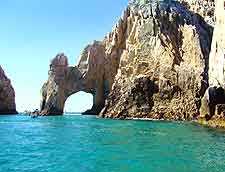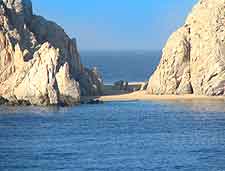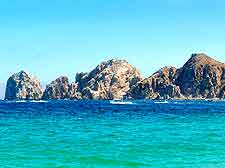Cabo San Lucas History Facts and Timeline
(Cabo San Lucas, Baja California Sur, Mexico)

The first archaeological evidence of human settlement near Cabo San Lucas dates back over 10,000 years in history. One of the first Europeans to set eyes on this southern Baja California area was a shipwreck survivor, who told tales on his return home about an island inhabited by 'Amazons' and filled with pearls and gold.
When Spanish conquistador Hernan Cortez heard these stories, he led a crew of three ships, filled with 600 passengers, to Santa Cruz Bay in 1535. Although Cortez saw no Amazons or riches during his expedition, he may have encountered sea lions as he sailed beneath the distinctive arch - where the sea that bears his name meets the Pacific Ocean at Baja California's southernmost tip.
Spanish Trading Port History
Cortez's navigator, Francisco de Ulloa, established the first permanent European settlement in present-day Cabo San Lucas in 1537. The area's original residents were Pericú nomadic groups who hunted, fished and lived a metal-free Neolithic lifestyle.
Although Cabo San Lucas was a bustling Spanish treasure ship port and pirate stopover for 50 years, its first permanent fortress wasn't established until 1587. This was the year Sir Thomas Cavendish captured the Great St. Anne Spanish treasure ship. The fort, which helped to keep foreign pirates away, and the discovery of pearls in the Sea of Cortez, led to even more permanent settlements along the Baja Peninsula.

Jesuit Mission and Fishing Village
In 1730, after Jesuit settlers established a mission called Jose del Cabo north of Cabo San Lucas, the neighbouring communities became known as Los Cabos. Lack of a steady water supply, however, restricted development in the towns. The Church of San Lucas is one of this era's few surviving buildings. By 1842, there were still only 20 people and two houses in Cabo San Lucas.
Cabo San Lucas did not grow substantially until 1917, when an American company established a floating tuna platform and a fish plant in the village. The first sport fishing tourists to visit Cabo San Lucas had to travel by long-range yacht, tiny planes or over 1,500 km / 932 miles of bumpy dirt roads to reach their destination. By the 1930s, the population had reached roughly 400.

Thriving Tourist Destination
More and more Hollywood celebrities discovered Cabo San Lucas after WWII, and the 1950 opening of the posh Las Cruces hotel further increased the village's popularity as a retreat for the rich and famous. Access to Cabo San Lucas became much easier for tourists with more modest budgets after the 1974 construction of Baja California's main peninsular motorway.
Modern-Day History
Today, many of the tourists who visit Mexico's second-fastest growing tourism resort have made Cabo San Lucas their permanent home. Most of these newcomers are Mexicans arriving from other parts of the country, along with Americans seeking a warm and peaceful place to retire. American expats form at least 70 percent of the present population.
This rapid growth along the 'golden corridor', between Cabo San Lucas and the more laid-back San Jose del Cabo, has come at a price. The road's numerous timeshares, hotels and golf courses have threatened to engulf the region's unique marine life and desert habitat. The stunning ocean view from this scenic coastal road, however, remains unspoilt.
 The first archaeological evidence of human settlement near Cabo San Lucas dates back over 10,000 years in history. One of the first Europeans to set eyes on this southern Baja California area was a shipwreck survivor, who told tales on his return home about an island inhabited by 'Amazons' and filled with pearls and gold.
The first archaeological evidence of human settlement near Cabo San Lucas dates back over 10,000 years in history. One of the first Europeans to set eyes on this southern Baja California area was a shipwreck survivor, who told tales on his return home about an island inhabited by 'Amazons' and filled with pearls and gold.
